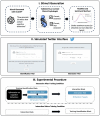One-shot intervention reduces online engagement with distorted content
- PMID: 40104683
- PMCID: PMC11914320
- DOI: 10.1093/pnasnexus/pgaf068
One-shot intervention reduces online engagement with distorted content
Abstract
Depression is one of the leading causes of disability worldwide. Individuals with depression often experience unrealistic and overly negative thoughts, i.e. cognitive distortions, that cause maladaptive behaviors and feelings. Now that a majority of the US population uses social media platforms, concerns have been raised that they may serve as a vector for the spread of distorted ideas and thinking amid a global mental health epidemic. Here, we study how individuals ( ) interact with distorted content on social media platforms using a simulated environment similar to Twitter (now X). We find that individuals with higher depression symptoms tend to prefer distorted content more than those with fewer symptoms. However, a simple one-shot intervention can teach individuals to recognize and drastically reduce interactions with distorted content across the entire depression scale. This suggests that distorted thinking on social media may disproportionally affect individuals with depression, but simple awareness training can mitigate this effect. Our findings have important implicasstions for understanding the role of social media in propagating distorted thinking and potential paths to reduce the societal cost of mental health disorders.
Keywords: cognitive behavioral therapy; depression; large language models; mental health; social media.
© The Author(s) 2025. Published by Oxford University Press on behalf of National Academy of Sciences.
Figures




References
-
- Richter D, Wall A, Bruen A, Whittington R. 2019. Is the global prevalence rate of adult mental illness increasing? Systematic review and meta-analysis. Acta Psychiatr Scand. 140(5):393–407. - PubMed
-
- Lorenzo-Luaces L. 2018. The evidence for cognitive behavioral therapy. JAMA. 319(8):831–832. - PubMed
-
- Beck AT, Haigh EAP. 2014. Advances in cognitive theory and therapy: the generic cognitive model. Annu Rev Clin Psychol. 10(1):1–24. - PubMed
-
- Webb TL, Miles E, Sheeran P. 2012. Dealing with feeling: a meta-analysis of the effectiveness of strategies derived from the process model of emotion regulation. Psychol Bull. 138(4):775–808. - PubMed
LinkOut - more resources
Full Text Sources

